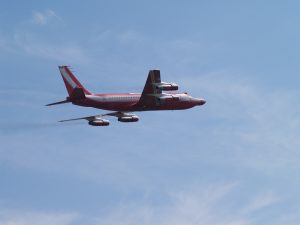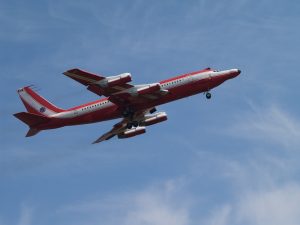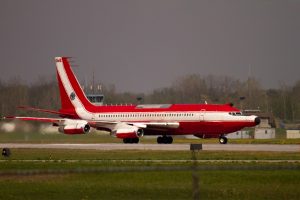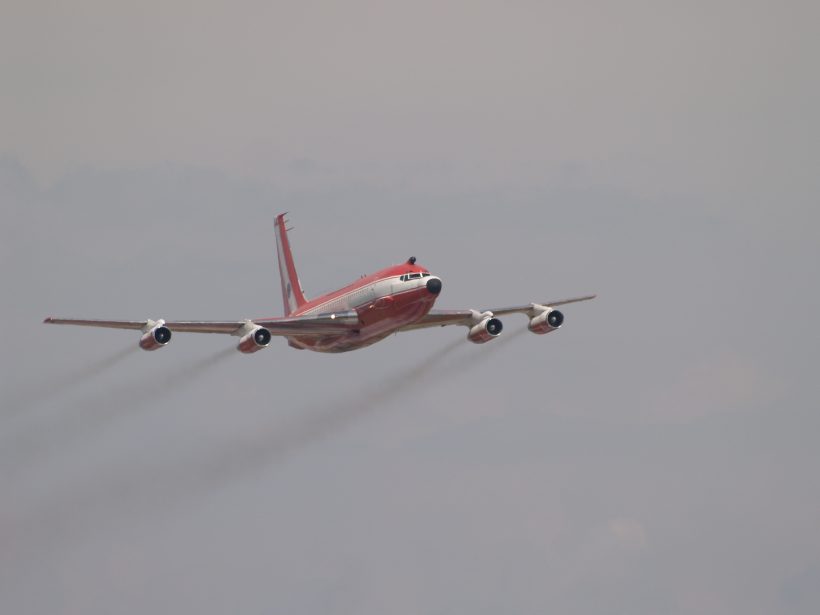LAST FLIGHT OF THE BOENG 720
Serendipity
The Resident Wife (TRW) and I were in Trenton early May 9, 2012 on business and stopped in at a restaurant for breakfast. As I was about to order, a Hercules aircraft flew low overhead startling me. Almost spilled my coffee.
“Say, if you’re interested, there’s a plane coming in for its last flight to-day at 1:00 p.m.,” said our waitress. She didn’t have any other details to offer.
By 12:45 we were parked along RCAF Road, a short distance from the National Air Force Museum of Canada (NAFMC) in Trenton asking if anyone knew what was coming in.
“A 720,” an older gentleman told me. “Never heard of it,” he added.

By 1 pm the parking lot was full and everyone was abuzz. It was almost like a tailgate party. Strangers happily talked to strangers.
“It used to be a troop carrier,” said one.
“Its claim to fame is that it was built to test the Iroquois engines for the Avro Arrow,” said another.
Executives from Pratt & Whitney, the engine manufacturer, had driven from St. Hubert to witness this last landing. The Director of the Canadian Aviation and Space Museum of Ottawa was also present. They thought it wonderful that I had heard of this from a waitress and that word of mouth had inspired such a great turnout. They were all smiles. For me it was another example of serendipity, of timing, of being in the right place at the right time. Usually, as in Murphy’s Law, I’m at the wrong place at the wrong time.
While a group of us were chatting awaiting the big performance a reporter stopped by. He had been on the base and learned that the plane was still parked in Montreal. A thunderous storm was passing through and kept it grounded. He was on his way to Tim Hortons for coffee and kindly dropped by to keep us informed. The plane wouldn’t arrive before 1:45 pm.
Later, a photographer happened by and told us that his buddy, an ATC (Air Traffic Controller) on base had told him the plane was still grounded and wouldn’t arrive before 2:45 pm.
Strangers became friends and talked about everything that came to mind. TRW chatted for hours, literally, to a retired Toronto police homicide detective. I chatted with a photographer and reporter, both of whom had cameras and lenses to dream about. At 3 p.m. one of the spectators with a radio unit tuned into base communications said that the 720’s arrival was ATS (any time soon).

Lights in the distant sky and radio squawk announced the 720’s approach for a fly past for photographers. “The pilot has the option of a second go round,” one of the Pratt & Whitney crew told me. Not to disappoint those of us on the ground, the pilot did another go round. Truth be known he was probably extending the experience for the crew as this was their very last and certain nostalgic flight. Perhaps a moment or more to savour the forever experience?
SEPTEMBER 29, 2010 – On Wednesday, September 29, 2010, the operational service life of the Pratt & Whitney Canada (PWC) Boeing 720-023B engine test-bed C-FETB came to an unheralded conclusion when the aircraft landed at St.-Hubert, Quebec after completing its last test-flight, at 7:14 p.m. Eastern Standard Time. At the end of its CPCP calendar life the 720 had one remaining ferry-flight – to Trenton, as it turned out, on Wednesday, May 9, 2012 – for this classic aircraft.
Affectionately known as PINOCCHIO, this 720 is one of 154 that were produced, the last airworthy 720 in the world and it has been lent to the National Air Force Museum of Canada (NAFMC) in Trenton, Ontario home to Canada’s largest air base “for an indefinite period of time,” according to NAFMC Public Relations Manager Barb Neri. Boeing manufactured the 720s from 1959-1967.
Essentially the Boeing 720 is a smaller capacity, lighter medium-ranged version of the 707. Pratt & Whitney Canada have used the test bed aircraft to test more than 8 different families of engines for the past 24 years.
This particular plane was produced on October 28, 1960, flew on January 14, 1961 and was delivered to American Airlines on February 3rd. It was put in storage in August 1971 at Tulsa, Oklahoma. On September 25, 1971 Middle East Airlines Airliban (MEA) bought the plane. It was forced to stay away from its main base in Beirut, when Israel invaded Lebanon in June 1982 and occupied much of the country, until 1985. Based in Orly, near Paris, the plane occasionally flew passengers for Air France and Air Inter, another French airline.

PWC bought the plane in December 1985 re-registering it as C-FETB (Flying Experimental Test Bed) on January 10, 1986. Following modifications a PWC crew flew the airplane across the Atlantic on October 12, 1986. Further modifications between October 1986 to January 1988 equipped the 720 to test a variety of engines before it was retired on September 29, 2010.
Why is this so historical? Simply put, aviation museums around the world have an abundance of WW2 aircraft and actively seek out flyable restorations. However, the classic jetliner era including the likes of a 707 or DC-8 in engine running condition are about to vanish. Except, now, the NAFMC has stepped up and accepted the PWC 720 for display. 8Wing Operations will store the donated aircraft. “After the necessary prep work on the aircraft is complete we hope it will be ready to be displayed in the airpark by July,” said Barb Neri. The 720 will get the park’s 21st spot in the museum’s outdoor airpark. Presently there are 25 aircraft on display at the museum, 20 of which are in the 16 acre Airpark adjoining the museum building. Look for the red and white plane with the long nose. For more information, such as operating hours, use a search engine to look up NAFMC.

